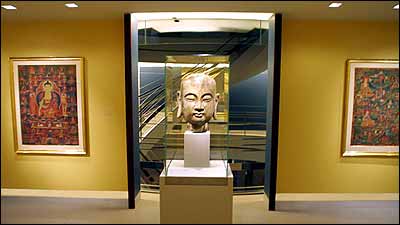
Tibetan and Chinese works at the new Rubin Museum, on 17th Street. Photo Credit: Liz Brown for RMA
The Buddha works in mysterious ways. At the behest of an energetic Jewish couple, the Enlightened One has symbolically claimed the former Barneys emporium in Chelsea, once the downtown center of hothouse fashion, and transformed Mammon into a temple of Himalayan art. The new Rubin Museum won’t inspire New Yorkers to abandon their worldly cravings anytime soon. But the unlikely cultural segue—the two-step from dandified fashion to esoteric Tibetan Buddhism—has a kind of crazy-monk genius that suits contemporary New York. Anything seems possible, at least momentarily, if Barneys can yield to the Buddha. An enlightened Donald Trump. A kinder, gentler Bush.
The museum, housing about 900 works in 25,000 square feet of exhibition space, is the creation of Shelley and Donald Rubin. The founder of MultiPlan, Inc., a managed-health-care network, Donald Rubin began buying tangkas (Himalayan paintings on fabric) with his wife about 25 years ago. As they built their fortune, they crowded their home and the walls of MultiPlan with an astonishing array of art—mostly but not exclusively from Tibet—ranging in date from the fourteenth to the nineteenth century. During the late nineties, reluctant to give their collection to an established institution that would bury it in storage, they decided instead to construct their own museum and, in an inspired bit of serendipity, bought the Barneys building in a bankruptcy sale for $22 million.
“Rubin emphasizes the living quality of Buddhist art, its ability to stimulate an ‘emotional rush.’ ”
A six-story spiral staircase, which Andrée Putman originally designed for Barneys, centers the exhibition space. If the stairs once evoked a Hollywood romance—Garbo swirling downward in a feathery boa to meet her waiting lover—they now suggest cycles, transcendence, and the rippling forms of Buddhist art. The architect Richard Blinder oversaw the transformation from a consumer showpiece into a museum, and Milton Glaser, together with Tim Culbert and Celia Imrey, worked on the design of the galleries. Overall, they have created a jewel-like and serene setting for the art.
Though he admires scholarship, Rubin does not want his museum to become forbiddingly academic. He emphasizes the living quality of Buddhist art, its ability, he says, to stimulate an “emotional rush” in viewers. The floor-wide exhibitions around the staircase are therefore organized by theme rather than by particular time or place. One floor explores “Sacred History: Sages and Stories,” for example; another, the “Demonic Divine.” The top floor contains Tantric and especially ethereal visions of transcendence. (In the basement gallery, the photographer Kenro Izu is exhibiting rapturous photographs of the Himalayan region.) Rubin himself, who lost much of his family in the Holocaust and continues to be troubled by the eruptive violence in the human heart, takes a special interest in the demonic strains of Buddhist art: The nightmarish imagery represents a Buddhist’s determination to confront internal demons—and tame them.
Although great encyclopedic institutions are indispensable, many people prefer smaller, more personal collections. They bring art to life, as the Rubins know. To celebrate the opening, more than 100 contemporary artists have designed flags that evoke the prayer flags of the Himalayas; sidewalk artists have created art that will disappear over time. Children will always be welcome in the galleries, where storytellers will play a significant role. In contemporary American culture, Buddhist thought has developed an important and ongoing tradition, which the founding of the Rubin Museum will happily strengthen. To maintain that lively energy, the museum should, of course, avoid becoming too designed, pretty, or “New Age,” and respect the visceral power of real Buddhism. (Himalayan music comes from the belly of the earth. And everyone should try yak-butter tea at least once.) And the museum must develop an honorable relationship with living Tibet, which China is turning into a deathly museum. The Rubin has said it will not focus on politics, which is understandable, but it must also be careful not to become a silent apologist or polite enabler for the Chinese regime. The demons in Buddhist art are not just something to confront on a Chelsea Saturday.